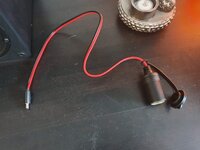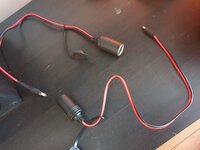Awesome 3-in-1 Battery Bank - How I done It -
- Thread starter Dellmassive
- Start date
-
- Tags
- dellmassive power-bank
I Just found a Nice 50W & 100W foldup Solar kit (with Mono SolarWorld Cells)
.
50W, 100w, 120W Kit . . . .




Premium Solar Panels and Accessory for Leisure and Marine Applications
BlueFusion Portable Folding Solar Panel Charger 50W, 100W, 120W
 Off Grid Applications
Off Grid Applications
Flex Power 50W, 100W, 120W
Lightweight and Portable
Portable Folding Solar Panel with Integrated Charge Controller
Electrical Characteristics
Panel Specification
Linear Power Warranty***
.
50W, 100w, 120W Kit . . . .



Premium Solar Panels and Accessory for Leisure and Marine Applications
BlueFusion Portable Folding Solar Panel Charger 50W, 100W, 120W
 Off Grid Applications
Off Grid ApplicationsFlex Power 50W, 100W, 120W
- Manufactured from High Efficiency Monocrystalline cells by SolarWorld GmbH, Germany.
- 25 Year Power Output Warranty***
Lightweight and Portable
- A quality product, designed to be portable and withstand outdoor environments.
- Charge mobile devices and batteries on the go.
- Off-grid charging of batteries for Caravans & RV, Camping and Hiking Equipment, Electric Outboard Trolling Motor, and Residential use.
 Inbuilt Charge Controller
Inbuilt Charge Controller
Portable Folding Solar Panel with Integrated Charge Controller
- Integrated Charge Controller, concealed inside the panel.
- USB and Battery Charger outputs.
- Charge Phones and Devices from USB socket, 5V, 1.2 Amp.
- Charge 12V or 24V Battery. 2m Battery cable, fused and alligator clamps.
- Excellent low light capabilities.
- High conversion efficiency.
Electrical Characteristics
| Electrical Specification: | |||
| Panel Model: | MD1199/50W | MD1199/100W | MD1199/120W |
| Peak Power (Pmax): | 50W | 100W | 120W |
| USB Charger Socket (max): | 5V, 1.2A | ||
| Battery voltage (V) *: | 12V / 24V (Auto Detect) | ||
| Discharge Current Rated(Amp): | 10A | ||
| Output power Tolerance: | ±3% | ||
| Power Temperature Coefficient **: | -0.39%/°C | ||
| Operating Temperature(°C): | -35 to +55 | ||
| Panel Output, Voc (V)/ Imp(A): | 21.3V / 2.8A | 21.3V / 5.62A | 21.3V / 6.67A |
| * Compatible with Sealed, Gel, and Flooded Batteries. Battery connection required to operate controller. Battery not included. ** Based on standard testing conditions. |
| Specification: | |||
| Cells: | Monocrystalline silicon solar cell manufactured by SolarWorld GmbH | ||
| Controller | Integrated Charge Controller concealed in zipped pouch. | ||
| Included Cable: | 2m battery cable with integrated fuse and alligator clips | ||
| Folded Case dimension (cm), L x W x D | 36 x 30 x 5 cm | 36 x 30 x 7.5 cm | 54 x 54 x 5 cm |
| Unfolded Panel dimension (cm), L X W | 118 x 36 cm | 118 x 72 cm | 180 x 54 cm |
| Weight (kg) | 2.4 kg | 3.9 kg | 5.2 kg |
| Note: | Specification subject to change, manufacturing tolerance and product improvement. Can withstand some drizzle, protect from substantial rain. |
- 25 Year, 80% power output warranty
- 1 Year limited product warranty
That's quite inefficient. Better off charging from your vans alternator for a quick boost.Liking this, Could charge my power chair batteries while out and about (using the 3 pin plug on the battery)
I work on power chairs and have done this mod a couple of times.
so you could use it instead leisure battery?
The100 Ah AGM costs almost the same amount, you do need to add a DC DC charger to charge it when the car running, you have to add 230V charger too...
*****************************************************************************
No, Not really, well kind of . . . . .
depends on your "use case" . . .
I would use this ALONGSIDE a proper leisure battery setup in the van.
*****************************************************************************
but this is awesome to use in the van, or in the tent, in the awning, around home etc etc.
it is rated at 100.5ah, but that's at the 3.2v cell level, which is why they offer the 372wh power.
in comparison, a 100ah AGM 12v battery would have 1200wh (or 600wh assuming 50% DOD)
*********************************************************************************
so i'd use it for anything portable, and alongside a Leisure setup.
but it could be used instead of a proper leisure battery install if you were only using small/light loads.
ie - USB phone charge, LED fairy lights, small 240vac appliances, Tablet charger, AirBeam pump, airbed pump, etc etc
Last edited by a moderator:
so you could use it instead leisure battery?
The100 Ah AGM costs almost the same amount, you do need to add an DC DC charger to charge it when the car running, you have to add 230V charger too...
no dc-dc needed for this unit . .
i just got one of these from ebay . .
Car 12v 5A 5.5mm x 2.1mm DC plug Charger Power Cable Lead 3m length Pro Quality

.
which is the same as what ALLPOWERS shows here>

ALLPOWERS®:Solar Generator kit ,Portable Power Station & Solar Panels
Allpowers offers a range of portable power solutions, including solar generators, outdoor camping RV portable power stations, home backup power stations, and solar panels. Recharge for a better life and empower a beautiful world.
 www.iallpowers.com
www.iallpowers.com

.
you can see the battery layout here:

and run times here:

Have a look here...I know no DC DC charger needed for Allpowers. It is obligatory for AGM leisure battery. You know smart alternator installed in T6.
I am planning to instal an AGM. I found that topic and I said to myself, that`s it, no AGM needed.
But now......

Dellmassive’s "How I Done It" blogs.
-- Dellmassive`s -- "How I Done It" -- thread -- ************************************************** Dellmassive`s -- "how I Done It" -- Thread ************************************************** Kit List And Stuff -- How I Done It & What I Use --...
Nope.Presumably this can't be used in anyway to jump start?
Would be nice if there was a combined option, then two birds with one stone
you need a Noco GB70 for that.
NOCO Boost HD GB70 2000 Amp 12-Volt UltraSafe Portable Lithium Car Battery Booster Jump Starter Power Pack For Up To 8-Liter Petrol And 6-Liter Diesel Engines: Amazon.co.uk: Car & Motorbike
NOCO Boost HD GB70 2000 Amp 12-Volt UltraSafe Portable Lithium Car Battery Booster Jump Starter Power Pack For Up To 8-Liter Petrol And 6-Liter Diesel Engines: Amazon.co.uk: Car & Motorbike
amzn.to

Which Jump Starter?
Advice required. Hi guys - I thought it would be prudent to carry one of those small JumpStarter powerpacks about with me as I have an electric lift seat installed for my better half and am a little concerned that with the extra demands on the van battery I might get caught out one wintery...
.
All charged up and ready to go again . . . . . . . .

we used one of these yesterday to power the VE DAY street party (following UK Gov social distancing guidelines obviously)





we had this plugged in to the 240v socket, running the music from the tablet.

plus keeping the other phones and tablets topped up..
the extra USB ports come in very handy when the neighbors phone went-flat . . .
..
Charging wise the above was from the 60w USB-C PD charger included. . . .
and below with the 12v socket lead in the van.


the mobile power setup worked a treat . . . . . and will move over to a camping scenario easily . . .
Roll on Summer camp .. . . . . . .

we used one of these yesterday to power the VE DAY street party (following UK Gov social distancing guidelines obviously)





we had this plugged in to the 240v socket, running the music from the tablet.

plus keeping the other phones and tablets topped up..
the extra USB ports come in very handy when the neighbors phone went-flat . . .
..
Charging wise the above was from the 60w USB-C PD charger included. . . .
and below with the 12v socket lead in the van.


the mobile power setup worked a treat . . . . . and will move over to a camping scenario easily . . .
Roll on Summer camp .. . . . . . .
That would depend in the specific voltage of the pack and the vans battery at that specific time.If you plug it into the van using the cigarette lighter when the ignition is off, does it charge the battery in the van or in the pack?
current could flow either way at that point as both sockets are live 24/7 and both source voltages could be higher or lower.
so either - or
but that is not really a good idea, the pack will not charge the starter battery in that way.
but, then van will charge this pack . . .when the engine is running and the vans socket volatge is higher than the packs voltage . . . . (ie 13.8v)
What's the normal voltage of the pack, 5V via USB out? Under what circumstances would the voltage be higher than the van battery on a DC basis?
(Sorry, not being difficult, just interested!)
this is what im thinking . . . .
The Pack voltage at the 12v socket is 12.5v ish when 100% on the battery pack.
but could drop to 10V at lower capacity.
The USB ports are 5v regulated.
The USB-C PD port is 5,9,12v regulated.
*****************************
so with a low van starter battery of say 11.6v current would flow from a charged power-pack at 12.5v.
and the other way around. . . . . . .
more normal would be a alternator and engine running voltage of 13.5v and the pack at 12.0.
so with the ignition off....
either the van or the powerpack could have the slightly higher voltage, so current would flow either - or depending which had the higher voltage.
******************************
i think the internal 3.7v cells are arranged into a 3S pack,
so the 3.7v cell, fully charged at 4.2v - 3spack of 4.2v*3= 12.6v


===

/

These units look awesome, at work I normally have to carry an inverter and battery around to get my panels to start so i will be investing soon.
Me too . . . i normally have to drag my Noco GB70 or GB150,m PLUS a Bestek 300W pure sine inverter around a building site in a backpack . . . . to power up remote POE network switches for cctv installations . . . before the main power is up. . . . this is much more compact and just as powerful. =)These units look awesome, at work I normally have to carry an inverter and battery around to get my panels to start so i will be investing soon.
The DC jacks have finally arrived . . . so i can make up some 12v outlet cables.
i managed to buy the DC5521 (5.5mm x 2.1mm) input/charge side cable easy enough.
but...
the output side is DC5525 (5.5mm x 2.5mm) so i had to get the plugs separate . .

then i got some 12v socket extension leads and cut them up, soldered on the DC5525 plug and ended up with this . .



im sure your asking . . . . . Why bother Dell` ? there is a 12v socket on the side . . . . .
good point . . . but in testing it seemed that the 12v socket was not voltage regulated. . . .
ie as the internal pack voltage dropped . . . . so would the socket voltage...
this can be seen here on unit#1 . . . . i run it down flat @ 0%.
the 12v socket outlet shows 9.9v


but when plugging the the new lead you can see 12.4v . . . . still at 0% . . .
this shows that the two ports on the other side are regulated to give out a steady 12.4V - which is great. (upto 5A max)

for comparison here is unit#2.
its fully charged to 100% . . . .

so the internal pack voltage is high at 12.2v and the output ports are also high at 12.2.v

back to unit#1 now i have a charger plugged in, it had charged to about 5% . . . .
you can still see the left socket is low @ 10.1v but the RHS sockets are at a regulated 12.4v.
why is this important? . . . .
well some devices like fridges and cooler boxes have Low-Voltage cut outs that are designed to stop your car battery from going flat . . .
which is great when its plugged into the vans AGM starter battery and running it low . . . they will cut out leaving you enough power to start the van (supposedly)
but not so good when running of a mobile unit like this,
the problem is the the left 12v socket @ 50% could be down to 10.5v . . . . which would cause the fridge to shut down,
or your Tyre inflator to run slow . . . .or, or, or, or ?
so now you can use the RHS ports from 100% - 0% and you will get 12.4v. ( 5A max ) per port.
the 12v socket on the LHS is rated for 10A max . . . . so higher current. but not 12.4v regulated.
The testing continues . . .
.
i managed to buy the DC5521 (5.5mm x 2.1mm) input/charge side cable easy enough.
but...
the output side is DC5525 (5.5mm x 2.5mm) so i had to get the plugs separate . .

then i got some 12v socket extension leads and cut them up, soldered on the DC5525 plug and ended up with this . .



im sure your asking . . . . . Why bother Dell` ? there is a 12v socket on the side . . . . .
good point . . . but in testing it seemed that the 12v socket was not voltage regulated. . . .
ie as the internal pack voltage dropped . . . . so would the socket voltage...
this can be seen here on unit#1 . . . . i run it down flat @ 0%.
the 12v socket outlet shows 9.9v


but when plugging the the new lead you can see 12.4v . . . . still at 0% . . .
this shows that the two ports on the other side are regulated to give out a steady 12.4V - which is great. (upto 5A max)

for comparison here is unit#2.
its fully charged to 100% . . . .

so the internal pack voltage is high at 12.2v and the output ports are also high at 12.2.v

back to unit#1 now i have a charger plugged in, it had charged to about 5% . . . .
you can still see the left socket is low @ 10.1v but the RHS sockets are at a regulated 12.4v.
why is this important? . . . .
well some devices like fridges and cooler boxes have Low-Voltage cut outs that are designed to stop your car battery from going flat . . .
which is great when its plugged into the vans AGM starter battery and running it low . . . they will cut out leaving you enough power to start the van (supposedly)
but not so good when running of a mobile unit like this,
the problem is the the left 12v socket @ 50% could be down to 10.5v . . . . which would cause the fridge to shut down,
or your Tyre inflator to run slow . . . .or, or, or, or ?
so now you can use the RHS ports from 100% - 0% and you will get 12.4v. ( 5A max ) per port.
the 12v socket on the LHS is rated for 10A max . . . . so higher current. but not 12.4v regulated.
The testing continues . . .
.
Similar threads
- Replies
- 17
- Views
- 1K
- Replies
- 1
- Views
- 1K
- Replies
- 9
- Views
- 603









